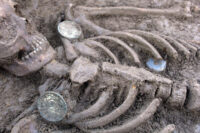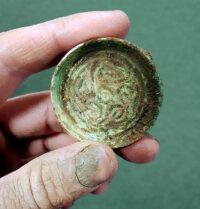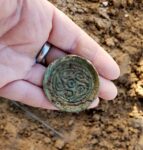 Archaeologists have found seven pairs of Anglo-Saxon saucer brooches, one pair in each of seven burials unearthed in an excavation in Gloucestershire. The Cotswolds Archaeology team discovered more than 70 Anglo-Saxon burials at the site, some of them containing luxury grave goods. They date to the 5th or 6th century.
Archaeologists have found seven pairs of Anglo-Saxon saucer brooches, one pair in each of seven burials unearthed in an excavation in Gloucestershire. The Cotswolds Archaeology team discovered more than 70 Anglo-Saxon burials at the site, some of them containing luxury grave goods. They date to the 5th or 6th century.
They’re known as saucer brooches after their shape: a circular central body with a raised rim. They are made of gilded copper alloy and were relief-cast (cast from a single piece of sheet metal) with decorative motifs in geometric  patterns. The one pictured right features five “running spirals” (meaning they’re connected to each other like they were written in cursive) around a central boss of pellet-in-ring style. This is the most commonly found motif on saucer brooches with geometric patterns.
patterns. The one pictured right features five “running spirals” (meaning they’re connected to each other like they were written in cursive) around a central boss of pellet-in-ring style. This is the most commonly found motif on saucer brooches with geometric patterns.
Ranging in size from 20-70 mm in diameter, saucer brooches were worn in pairs across the chest to fasten garments. Their designs are more simple  than, for example, the long square-headed brooches which were so large they offered much more space to create complex, highly sophisticated designs. The saucer brooches are still a high-status signifier for burials from this early period of Anglo-Saxon history in England, often found in tandem with other expensive pieces of jewelry.
than, for example, the long square-headed brooches which were so large they offered much more space to create complex, highly sophisticated designs. The saucer brooches are still a high-status signifier for burials from this early period of Anglo-Saxon history in England, often found in tandem with other expensive pieces of jewelry.
Those we uncovered were either positioned one on each shoulder, or two next to each other on the left shoulder with an associated clothing pin, giving a vivid impression of how they once looked on their wearers.
The “Vierfibeltracht” was an early medieval clothing style worn by West Germanic women between the 5th and 7th centuries. This costume owes its name to the fact that it was usually worn with two pairs of fibulae, different in shape.
Over a kind of tunic, the West Germanic woman wore a shawl or cloak draped over her shoulders and held in place by a pair of small fibulae placed at chest level. In the 7th century, after the Vierfibeltracht period, the pair of small fibulae is replaced by a large disc brooch (fibula).
From the “Vierfibeltracht” costume mostly the two small fibulae at chest level, the pair of bow fibulae in the pelvic area and the inorganic components of the belt and the hanger remain in the inventory of West Germanic women’s graves.
Could it be that those rather simple “saucer brooches” were particularly made for burial purposes, while the more expensive ones were kept or inherited, as the deposition of grave goods became out of fashion?
:hattip: